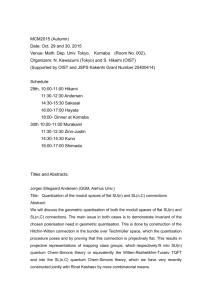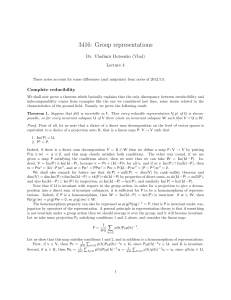handout4 - Buchanan-hgeo
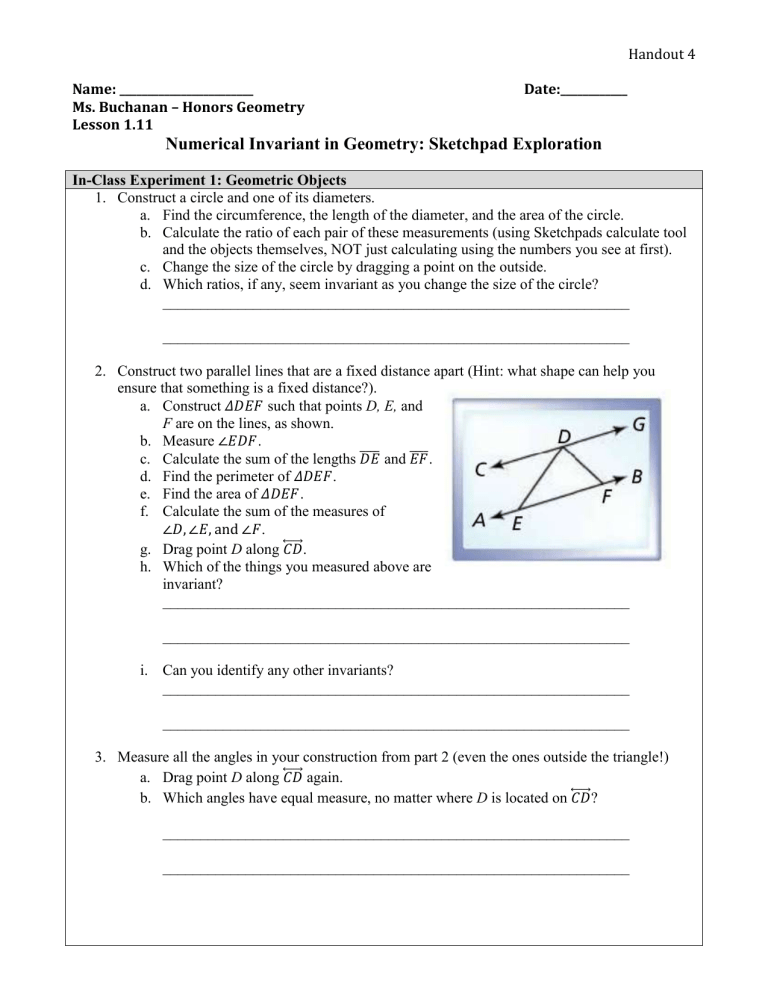
Name: ________________________
Ms. Buchanan – Honors Geometry
Lesson 1.11
Date:____________
Numerical Invariant in Geometry: Sketchpad Exploration
Handout 4
In-Class Experiment 1: Geometric Objects
1.
Construct a circle and one of its diameters. a.
Find the circumference, the length of the diameter, and the area of the circle. b.
Calculate the ratio of each pair of these measurements (using Sketchpads calculate tool and the objects themselves, NOT just calculating using the numbers you see at first). c.
Change the size of the circle by dragging a point on the outside. d.
Which ratios, if any, seem invariant as you change the size of the circle?
______________________________________________________________
______________________________________________________________
2.
Construct two parallel lines that are a fixed distance apart (Hint: what shape can help you ensure that something is a fixed distance?). a.
Construct 𝛥𝐷𝐸𝐹 such that points D, E, and
F are on the lines, as shown. b.
Measure ∠𝐸𝐷𝐹 . c.
Calculate the sum of the lengths 𝐷𝐸 and 𝐸𝐹 . d.
Find the perimeter of 𝛥𝐷𝐸𝐹 . e.
Find the area of 𝛥𝐷𝐸𝐹 . f.
Calculate the sum of the measures of
∠𝐷, ∠𝐸, and ∠𝐹 . g.
Drag point D along 𝐶𝐷 . h.
Which of the things you measured above are invariant?
______________________________________________________________
______________________________________________________________ i.
Can you identify any other invariants?
______________________________________________________________
______________________________________________________________
3.
Measure all the angles in your construction from part 2 (even the ones outside the triangle!) a.
Drag point D along 𝐶𝐷 again. b.
Which angles have equal measure, no matter where D is located on 𝐶𝐷 ?
______________________________________________________________
______________________________________________________________
c.
Which pairs or groups of angles have an invariant sum of 180° ?
______________________________________________________________
Handout 4
______________________________________________________________ d.
Challenge: Which two angles are such that the measure of one is always greater than the measure of the other?
______________________________________________________________
______________________________________________________________
4.
Draw 𝛥𝐴𝐵𝐶 . a.
Construct the midpoint D of 𝐵𝐶 . b.
Construct median 𝐴𝐷 . c.
As you stretch and distort 𝛥𝐴𝐵𝐶, find two segments such that their lengths are in constant ratio. d.
Are there any invariant areas?
______________________________________________________________ e.
Invariant ratios of areas?
______________________________________________________________
In-Class Experiment 2: Constant Sum and Difference
1.
Construct two unique quadrilaterals, two unique pentagons, two unique hexagons, two unique septagons, and two unique octagons. a.
Measure all the angles. b.
Calculate the sums of all the angles. c.
What two things are invariant among each type of polygon?
______________________________________________________________
______________________________________________________________
2.
You can divide a polygon with n sides into (𝑛 − 2) triangles. How might this help you find a rule that describes the sum of the measures of the angles of a polygon?
______________________________________________________________
______________________________________________________________
3.
Assume that the sum of the angle measures of a triangle is invariant. Write an argument that shows that the sum of the angle measures of an n -sided polygon is also invariant. Find a rule that will tell you the angle sum if you know n , the number of sides.
______________________________________________________________
______________________________________________________________
Handout 4
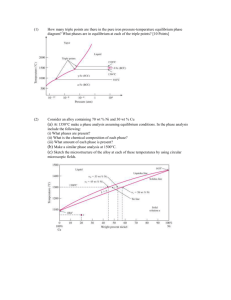
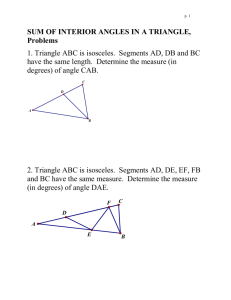




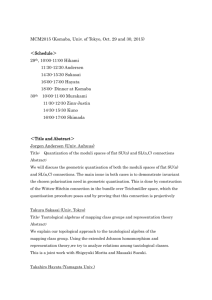
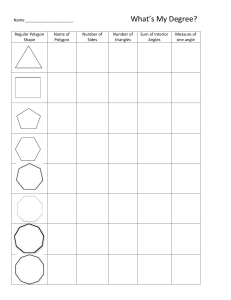
![7th Grade [Pre-Algebra] Math Vocabulary](http://s3.studylib.net/store/data/006617991_1-76ce0e26cff8b794b821343c050f71cb-300x300.png)

